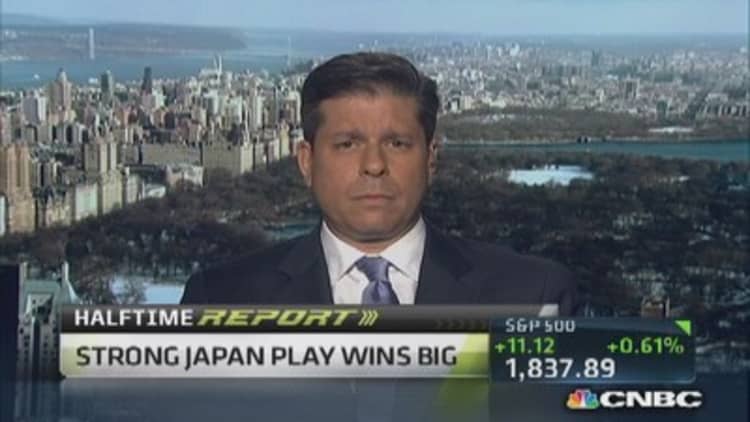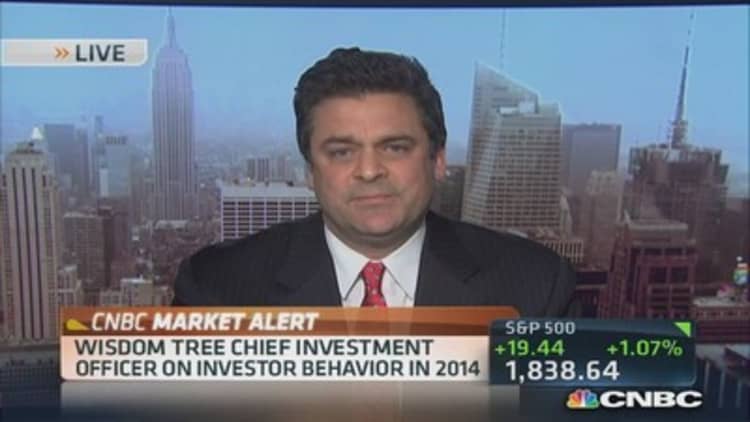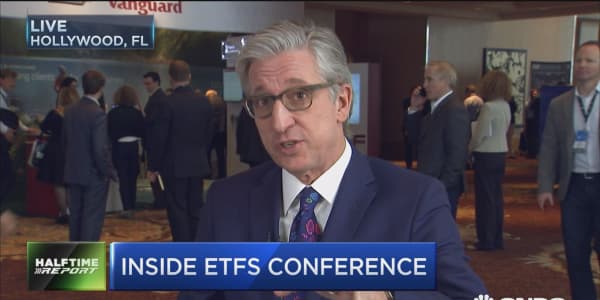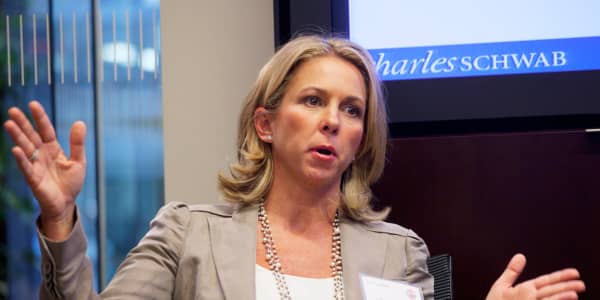The growth of the ETF market over the past few years has been nothing short of astounding. ETFs attracted more than $180 billion in new money from investors in 2013 and now hold more than $1.7 trillion in assets.
The numbers compared to traditional mutual funds are even more impressive: Over the past five years, ETFs have pulled in $772 billion in net new money, while investors have yanked $81 billion out of traditional mutual funds.
The reason? ETFs are, on average, cheaper, more transparent and more tax efficient than traditional mutual funds. But with 1,500 ETFs on the market today, not everything is rosy. The ETF "revolution" is diverse, containing things both good and bad. As we all gear up for 2014, I wanted to highlight three opportunities and innovations in ETF land that I'm most excited about—and three that have me the most concerned.
Opportunity #1: Commission-free ETFs
The most exciting thing to happen in ETFs in recent years is the dawn of commission-free trading programs at places like Charles Schwab, Fidelity Investments and TD Ameritrade.
While ETFs have been a great solution for institutional investors for years, until the dawn of these programs, they had been a terrible idea for the retail investor. If you're like me and you save $500 or $1,000 or $2,000 every month and you want to put it to work in the market, doing so with ETFs used to be impossible: The commissions would eat you alive!
But today you can trade more than 100 ETFs commission-free at Schwab and TD Ameritrade or move 65 different iShares ETFs at Fidelity.
One of the things I do at my website, ETF.com, is to track the lowest-cost ETF portfolio in the world. You can read about it here. It holds six ETFs, representing more than 3,500 stocks, 800 bonds and 19 different commodities. It's a great portfolio, and it has a blended expense ratio of less than 0.09 percent per year, or $9 for every $10,000 invested.
And the great thing? For 95 percent of that portfolio, you can trade it, rebalance it, do anything with it—for free—through Schwab.
[Note: The commodity portfolio included—the UBS Dow Jones Commodity Index ETN (NYSE ARCA:DJCI)—is not available under the free trading program at Schwab. But you can replace it with the slightly more expensive US Commodity Index Fund (NYSE ARCA:USCI), which is available and, quite honestly, a better fit for most investors. It relies on a strategy rooted in decades of academic research to rotate into commodities experiencing scarcity, which should lead to better long-term returns.]
Even with this quasi-active commodities fund, the portfolio will still cost you less than 0.10 percent in annual fees. It's an amazing deal. Commission-free trading programs have transformed the marketplace for retail investors.
(Read more: ETF unfinished business in 2014: crushing mutual funds)
Opportunity #2: Currency-hedged ETFs
The second most exciting thing to happen in ETFs recently has been the dawn of currency-hedged ETFs.
You may be familiar with the WisdomTree Currency Hedged Japan ETF (NYSE ARCA:DXJ). It was the single most popular new ETF in the world last year, pulling in more than $12 billion in assets. DXJ offered strong exposure to Japanese stocks, while hedging out exposure to the falling yen. Investors lucky enough to buy it at the start of 2013 enjoyed a stunning 40 percent move. And the currency hedging mattered: The traditional, unhedged iShares MSCI Japan ETF (NYSE ARCA:EWJ) rose only 26 percent. Being smart about currency netted you an additional 14 percent!
Today there is a whole suite of currency-hedged products. You can get currency-hedged exposure to Europe, to Germany, to Brazil, or to the entire international world.
Think of it this way: The euro is currently fetching $1.35. Wall Street consensus has that dipping to $1.22 or so over the course of 2014, as the U.S. Federal Reserve begins to taper. If that's right, a currency-hedged Europe ETF, like the WisdomTree Currency Hedged Europe ETF (NYSE ARCA:HEDJ) or the DB X-Trackers MSCI Europe Hedged Equity ETF (NYSE ARCA:DBEU), should outperform a traditional European investment by roughly 10 percent. Not bad for a day's work.

Opportunity #3: Innovative income strategies
The last major opportunity I see in ETFs right now is the option to diversify the search for income. Finding income right now is hard. Bond yields are low, and interest-rate risk is high—a brutal combination.
ETFs have done awesome things opening up new areas of the market to give investors access to income without as much interest-rate risk. Products like the PowerShares Senior Loan Portfolio (NYSE ARCA:) hold bank loans—short-term debt that won't get hit much if interest rates rise—and they are currently paying more than a 4 percent yield. That's better than the 2.8 percent yield you get on the 10-year Treasury.
Other investors have found solace and income in products that hold master limited partnerships, including the JP Morgan Alerian MLP ETN (NYSE ARCA:AMJ). MLPs are income-producing machines that benefit from the U.S. energy boom. AMJ is currently kicking off 5 percent in annual payouts.
From short-term high-yield bonds to dividend equities, ETFs offer lots of ways to get income, even in these challenging times.
(Read more: The bond market's ticking time bomb?)
And now for the flip side. Here are some big areas of concern in the ETF market.
Risk #1: Exotic products
Despite all these wonderful innovations, not everything's rosy in ETF land. There are still too many investors buying into many products that they don't understand.
One of the biggest offenders is the iPath S&P 500 VIX Short-Term Futures ETN (NYSE ARCA:VXX). This product is widely considered the best tool investors have for tracking the popular CBOE VIX volatility index. The appeal is obvious: Volatility is near all-time lows, and we all know it's going to rebound.
The problem is, just because VXX is the best tool we have to track the VIX doesn't mean it's a very good tool. In fact, it's terrible.
VXX uses volatility futures to gain exposure to volatility. Unfortunately, the current state of the volatility futures market means the carrying costs of holding that position long term are obscene. VXX is down 99.8 percent from its all-time highs, lost 60 percent of its value in 2013 alone, and with the way things look right now, will go nowhere but down in the future.
Despite all this bad news, investors have poured tons of money into VXX: $6.1 billion, to be exact. Sadly, just $900 million is left.
Don't get snookered into this one. ETFs have done a great job opening up new areas of the market, but sometimes they open up areas that should probably remain closed.

Risk #2: Smart beta and your behavior
One of the most exciting innovations in the ETF space over the past few years has been the advent of so-called "smart beta" strategies. These nifty strategies use quantitative insights to design indexes that can beat the broader market.
Some of these products are truly great and merit investigation. In 2012, investors fell over themselves investing in the PowerShares S&P 500 Low Volatility ETF (NYSE ARCA:SPLV), an innovative product that took advantage of investors' behavioral tendency to undervalue low-volatility stocks.
The problem with these smart beta strategies—as sexy and well researched as many are—is they will not perform well in all markets. How could they? The academic and behavioral anomalies they take advantage of play out over years, and sometimes over decades.
My biggest worry is that investors will jump into these strategies shortly after they've performed very well and then sell out when they inevitably hit a rough patch.
If you have the stomach to hold these things for the long haul, they can serve you very, very well. But if you've got an itchy finger, chances are, you'll sell at exactly the wrong point and lose your shirt.
(Read more: Can you beat the market with an index fund?)
Risk #3: Innovative income strategies
Last but not least is the flip side of one of the opportunities I outlined above. The impressive innovation we've seen in ETF land opening up to investors new areas of the market—like bank loans, MLPs or even niches such as emerging markets debt—has been wonderful. Investors have recognized the value of these products, and billions have rushed in.
All of which makes me worry. Some of these areas of the market have seen inflows that trump anything they've experienced before. Not only has that compressed valuations—some observers think MLPs are starkly overvalued right now, for instance—but it's set things up for a difficult exit if the market experiences a sharp pullback.
A market like bank loans or emerging markets debt could sell off hard if investors head for the hills, and you have to be prepared for the pain of deep discounts and liquidity risk if you're going to play in this market.
Conclusion
It's important when you're reading about ETFs to remember what an ETF really is: a very efficient wrapper for holding other investment products. That's it!
Sure, it's usually a better wrapper than a traditional mutual fund—cheaper, more flexible and more transparent—but it's just a wrapper. There's nothing about putting a bad investment idea into an ETF that transforms it into anything good.
You can expect to see a lot of innovation in the ETF space in 2014. There are more than 900 ETFs in registration at the Securities and Exchange Commission, and there are thousands more in the minds of investors daydreaming on the beach. Some of those innovations will be good; some will be bad. Just make sure you take the time to tell which is which.
—By Matt Hougan, president, Analytics and Publications at ETF.com.
(At the time he wrote this article, Hougan had a long position in DXJ. Positions can change at any time.)




